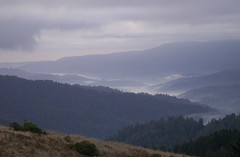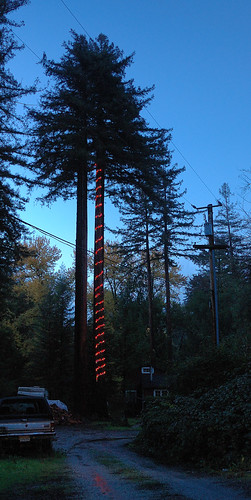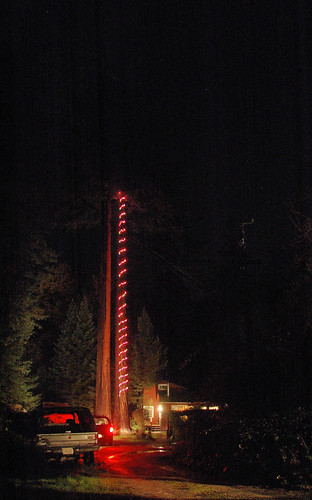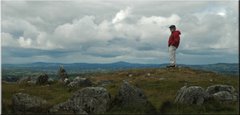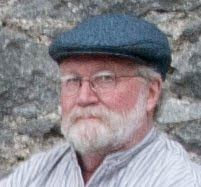The trees you can see from this vista point along California Highway 9 are almost entirely sequoia sempervirens, coastal redwoods, and their magnificent height and abundance hides thousands of homes -- including Ft. Harrington, which is roughly in the center of this frame -- from view.
The view from this place a hundred years ago would have been very different. After the great San Francisco earthquake and fire of 1906 (which actually devastated most of the Bay Area, not just San Francisco), this land was almost entirely clear-cut to provide building materials for the great reconstruction. That means that essentially all of the trees you see in the above photo are juveniles in the reckoning of redwoods, only about a century old. Between 1920 and about 1960, as the second-growth redwoods were growing up, the shorter trees of the blanketing forest allowed some things to exist profitably that are now long gone: many swimming pools behind dams in creeks (because shorter trees allowed more sunlight to reach the ground) and even an airport (which is now the Boulder Creek Country Club's golf course), for example.
 Part of a poster for the long-gone Boulder Creek drive-in movie theater from half a century ago -- when the re-growing forest was only about half as high as it is now. Two things that were snuffed out by the forest's re-growth are evident in its map: the airport and a big swimming pool. (Click on the image for a higher-resolution view.) Poster courtesy of Jeff Liebermann. Note that apostrophe abuse is not a new phenomenon.
Part of a poster for the long-gone Boulder Creek drive-in movie theater from half a century ago -- when the re-growing forest was only about half as high as it is now. Two things that were snuffed out by the forest's re-growth are evident in its map: the airport and a big swimming pool. (Click on the image for a higher-resolution view.) Poster courtesy of Jeff Liebermann. Note that apostrophe abuse is not a new phenomenon.Many of the trees in the photo at the top of this entry, when seen up close, are members of tight, circular groups. One such group is on the Ft. Harrington grounds:
 The summer furniture and patio occupy the footprint of the surrounding redwoods' ancestor, the ancient giant that lives on in its offshoots.
The summer furniture and patio occupy the footprint of the surrounding redwoods' ancestor, the ancient giant that lives on in its offshoots.Hundred-foot tall trees, while they may be "juvenile," can still be a problem to those who live underneath them if they are not cared for. Redwoods tend to shed limbs as part of their growing process. Trouble is, the limbs they shed are typically as big as full-grown pine trees in other climes. (Adam, I'm sure, remembers very well how impressive such shed limbs can be when they hit the ground -- he was visiting during a winter storm in the first year or two of our living here when several of them shook the earth. The previous occupant of this place neglected her trees' care.) It's wise to have weakened limbs removed before they break off on their own. Intentionally-removed redwood limbs are called "maintenance expenses;" spontaneous fallers are called "widow-makers."
There are two different ways of thinning potential widow-makers that local arborists tend to use: selective thinning and "columnization."

The above photo shows three circles of second-growth redwoods: the one on our property whose base was shown above (left), one on our thoroughly irresponsible neighbors' property (center), and one on a good neighbor's property (right). Ours is pretty much indistinguishable from the reprobates' cluster, because our tree-caretaker's philosophy is to take only those limbs that pose a danger. His (and our) preference is to leave the trees looking as much like they naturally would as possible, and thus the appearance of our trees is pretty much like neglected ones'.
The right-hand clump shows the other way of caring for them: just shave everything up to the point where you'd better leave needles for survival. Our tree guy snortingly calls this approach "columnization," and, until two weeks ago, I never would have thought that this particular neighbor would go for that look.
But she did. Two weeks ago. Before that, her trees looked pretty much like ours.
I didn't ask her about it, because the opportunity never arose in passing, and, besides, that's the kind of thing we tend to leave each other alone about here in Creepy Hollow.
On Christmas Eve, Diane and I drove up to Pleasant Hill, a couple of hours away, to celebrate the holiday with Grace-the-Granddaughter, Adam, Adrianne, and a whole gaggle of the clan. We didn't get back until well after dark... and were then well and truly treated to what our neighbor had in mind when she had her trees "columnized." The next day, Christmas day, I took a series of photos from late afternoon to dark, that shows her plot:
What a HOOT! It's like suddenly having an illuminated Washington Monument plunked down in your little hollow! The lights extend well over a hundred feet up the tree (I know; I used a high-precision Fies Protractor for the measurement computations) and are visible throughout the neighborhood. She says that next year she may have the remaining, high-altitude branches festooned with lights, too, and I hope she does. Then it would be a hundred-foot arrow of lights pointing straight UP.
Meanwhile, the Ft. Harrington Christmas Tree was of much more modest scale:
More about Christmas will be posted here soon, but Christmas isn't really over yet. I'll leave you now with how Emma looked yesterday while presents were being opened:
Please click on the above images for higher-resolution versions, especially the ones of our neighbor's tree.
